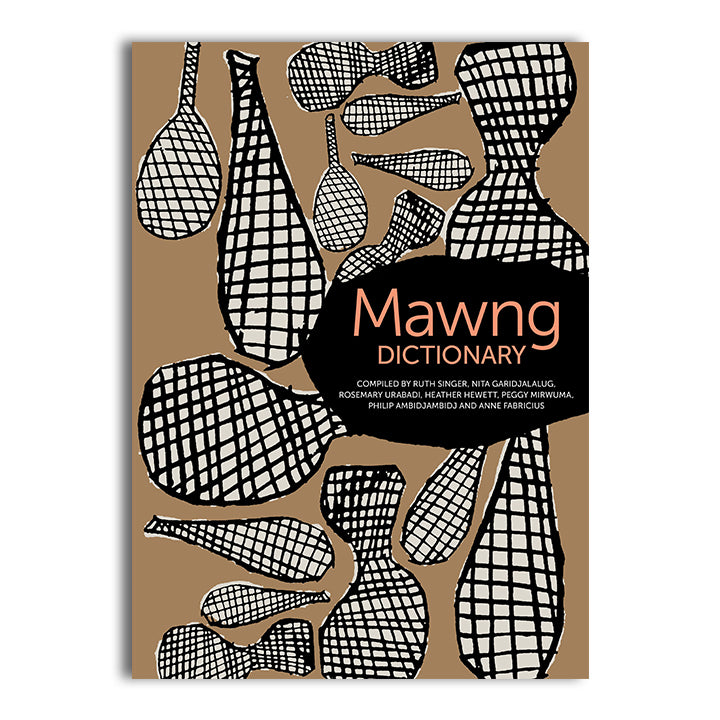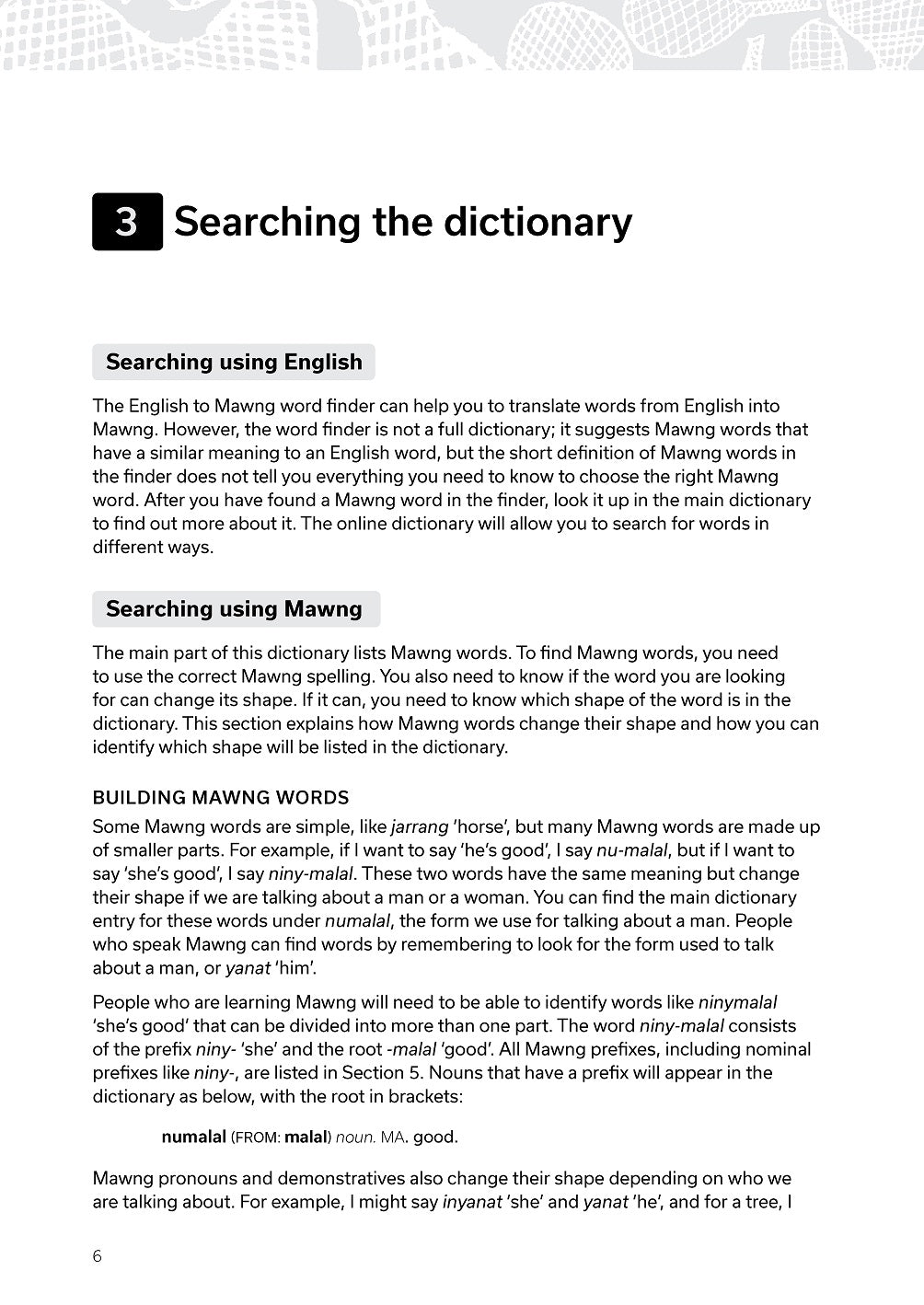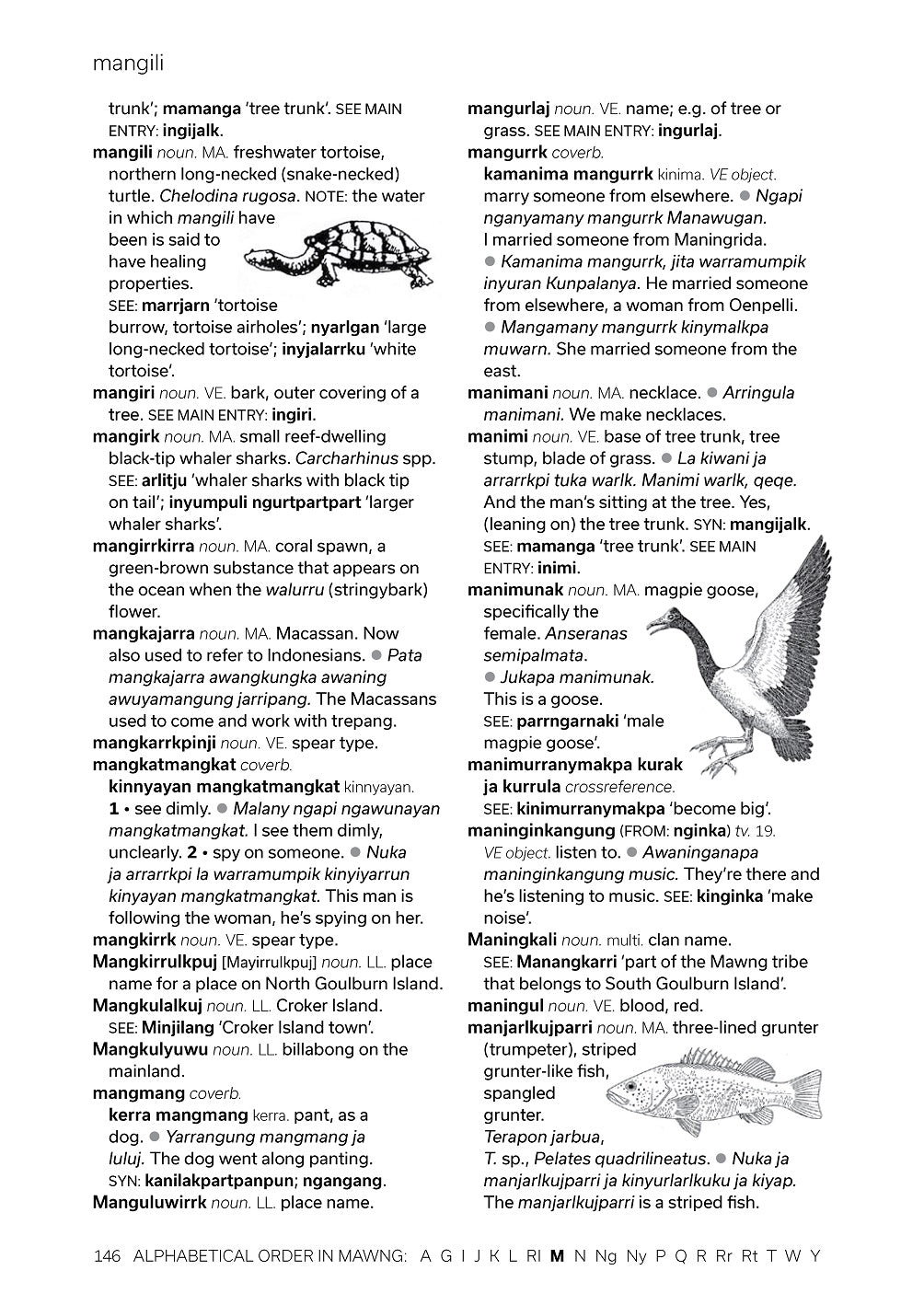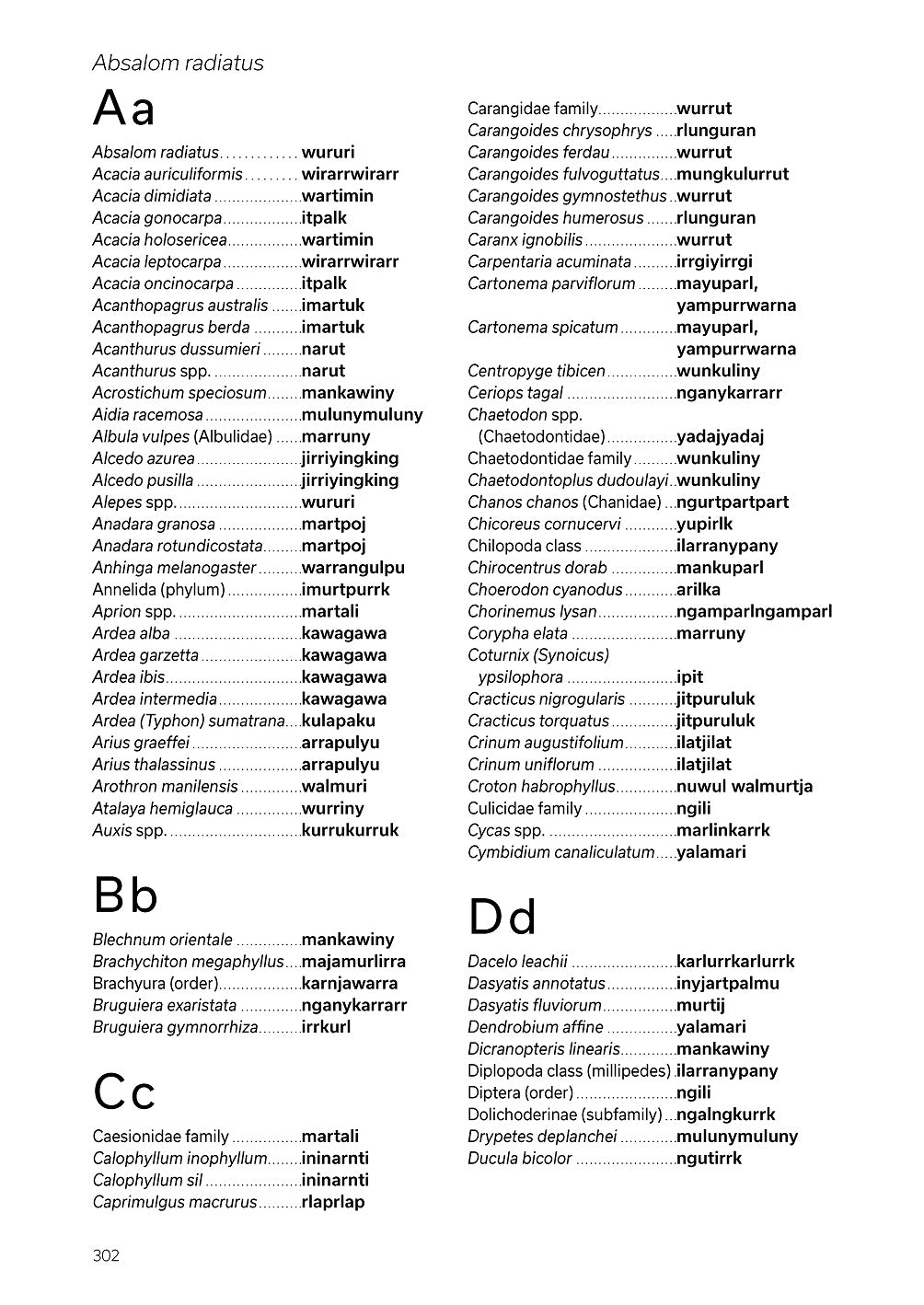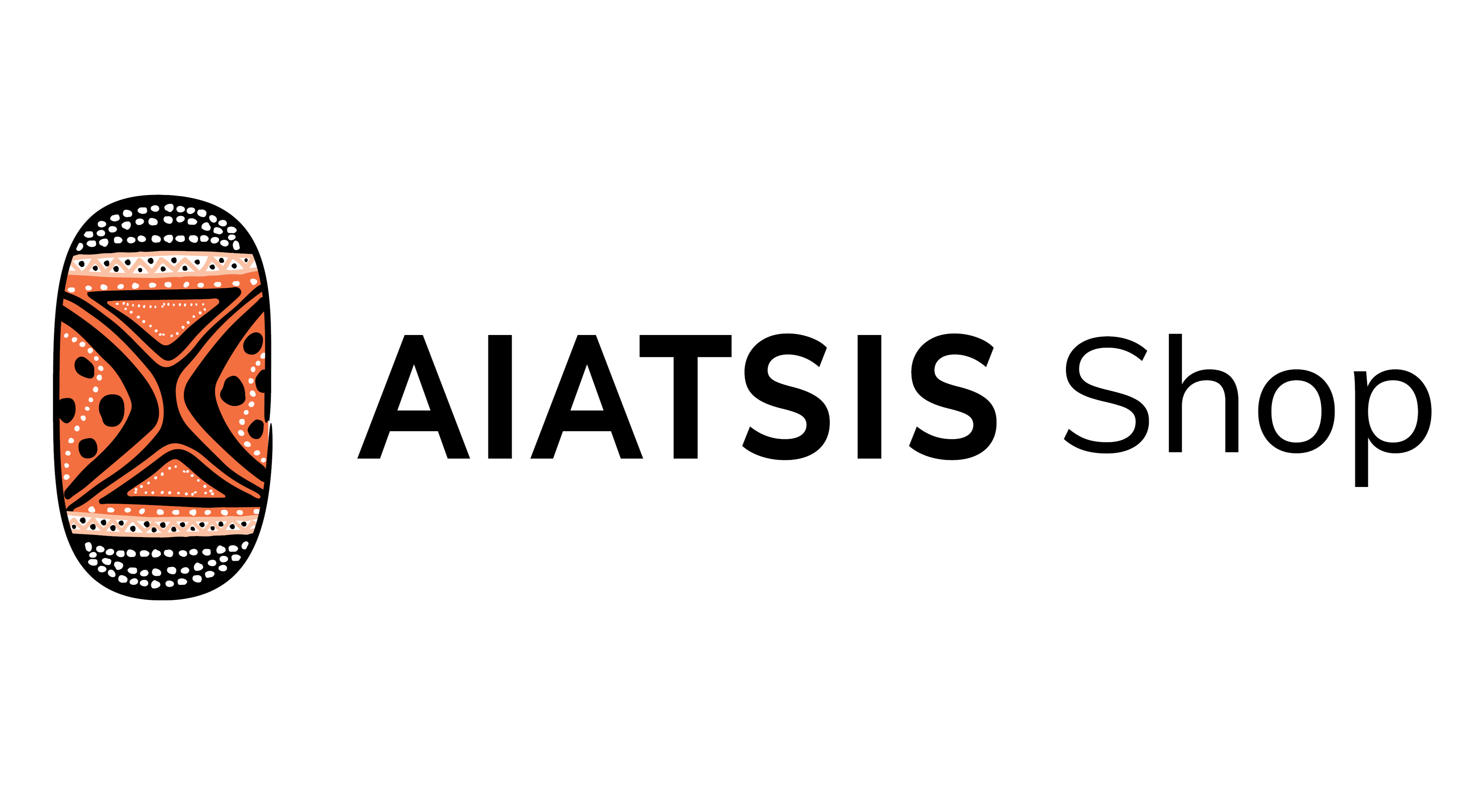Mawng Dictionary
Mawng Dictionary
AIATSIS
Couldn't load pickup availability
Mawng is a language of western Arnhem Land in the Northern Territory of Australia. It is the main language of Warruwi community and is spoken by about 400 people of all generations. Mawng is associated with the islands of Warruwi and Weyirra (North and South Goulburn Islands) and an area of the mainland near the islands. The Mawng Dictionary is the most comprehensive ever published. It contains information about plants and animals, cultural practices, place names and kinship terms, including tri-relational kunteypi terms. There is an introduction to Mawng with explanations of the spelling system and kinship. It includes many illustrations, an English word finder, and lists of kinship terms, verb roots and scientific names for plants and animals.
Production Details
- Paperback
- 240mm x 170mm
- 320pp
- Released 1 August 2021
- ISBN 9781925302707
Excerpt
Content
Preface
Contributors
Authors
Acknowledgments
1 The Mawng language and people
2 How to use this dictionary
Layout of a dictionary entry
Mawng spelling
3 Searching the dictionary
Searching using English
Searching using Mawng
4 Mawng dictionary entries explained
Part of speech
Grammatical information that follows the part of speech
Pointers to related words
Cross-references
Sources for example sentences
5 Words that change shape
Pronouns and demonstratives: saying who we are talking about
Nominal prefixes: the start of nouns
Verbal pronominal prefixes: the start of verbs
Verb suffixes: the endings of verbs
6 Words for family
Skin names
Simple kin terms
Totems
7 Sign language
8 Different ways of speaking Mawng
9 More on Mawng spelling
10 Plant and animal names
11 References
12 Resources on the Mawng language
13. Mawng to English dictionary
14. English to Mawng word finder
15. Scientific name finder
16. Appendices
Appendix A. List of skin names, simple kin terms, matrimoiety and totem names
Appendix B. List of kinship verbs
Appendix C. List of kunteypi terms
Appendix D. List of verbs ordered by their root
List of figures
Figure 1. Skin names (subsections)
Figure 2. Simple kin terms
List of tables
Table 1. Letters and sounds in Mawng
Table 2. Mawng consonant phonemes
Table 3. Parts of speech used in dictionary entries
Table 4. Demonstratives and the article
Table 5. Pronouns
Table 6. Nominal prefixes
Table 7. Intransitive verb prefixes
Table 8. Transitive verb prefixes
Table 9. Mawng verb conjugation classes
Table 10. Mawng totems (matries or phratries)
Map
The area of land associated with the Mawng language
About The Author
Ruth Singer has worked as a linguist with Warruwi community since 2002. She worked closely with Nita Garidjalalug and Rosemary Urabadi on the dictionary. She manages the Mawng Ngaralk website, produces films in Mawng and other local
languages and supports Warruwi school’s Mawng classes. She is based at the University of Melbourne.
Nita Garidjalalug worked closely with Ruth Singer to check
dictionary entries. Together they investigated verbs, and worked on plant and animal names and kin terms. Nita was a health worker at Warruwi clinic, and with Peggy Mirwuma wrote a book on traditional plant medicine.
Rosemary Urabadi is an expert on Mawng. She studied linguistics at Batchelor Institute and worked at Warruwi school on bilingual education materials, taught literacy, wrote books and recorded the knowledge of Elders. Rosemary researched kin terms for the dictionary.
Heather Hewett (née Hinch) arrived at Warruwi in 1952 as a missionary nurse. She learned Mawng to provide better care for her patients. She studied linguistics and compiled an early version of the dictionary and other Mawng resources. She helped establish the Mawng–English bilingual program at Warruwi school.
Peggy Mirwuma (deceased) worked at Warruwi’s translation centre and bilingual literature production centre for many years. She worked on literacy, edited dictionary entries, and wrote and illustrated readers for children. She translated Bible stories and illustrated books on health and diet for the Warruwi clinic.
Philip Ambidjambidj (deceased) worked at Warruwi’s translation centre and bilingual literature production centre for many years. He worked on Mawng literacy and developed dictionary definitions. He translated Bible stories, wrote and illustrated children’s books, and translated and illustrated books on health and diet.
Anne Fabricius (née Dineen) received a grant in 1990 to convert the Mawng dictionary from paper to electronic format. She worked at Warruwi in 1990 and 1991 with David Mindabul, May Meiyayanga, Toby Dadayn, Paul Naragoidj, Tommy Gagaraba and Maggie Margalgala Marawa. They expanded the dictionary and included plant and animal knowledge. Anne now works in Denmark at Roskilde University.
About The Cover
Cover image and interior graphics by Linda Najinga.
